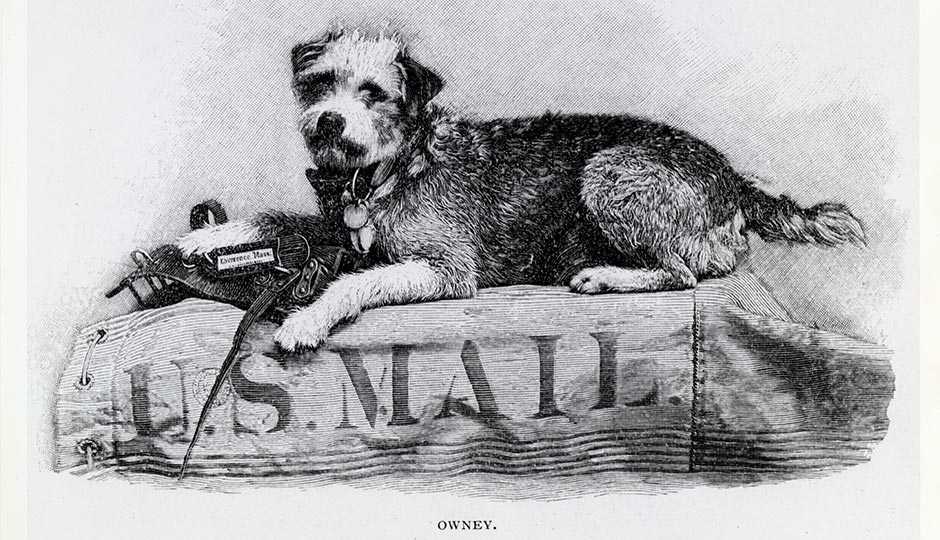11 Things You Might Not Know About Owney, the Post Office Dog

Owney, the unofficial mascot of the Railway Mail Service in the 1890s. Public Domain
Earlier this month, we wrote about how John Wanamaker became Postmaster General of the United States during his long, strange life. In researching that piece, we ran across Wanamaker’s connection with the shorter but perhaps even stranger life of Owney, a stray terrier who eventually was named the Official Mascot of the Rail Mail Service. On this date in 2011, the Postal Service honored Owney with a commemorative stamp. Here, a quick look back at the dog who traveled around the world, became a national hero, and has been celebrated in poems, books and songs.
- Owney, a border terrier, was found abandoned at the Albany post office in 1888 by a postal worker named Owen. The dog apparently wandered in the back door of the post office and went to sleep on a mailbag. When the pup’s mailroom presence was later discovered by the supervisor, fellow workers declared that he was “Owen’s dog,” and the name “Owney” stuck. The supervisor let the pup stay, against post office rules.
- Owney didn’t like to be separated from his mailbags; when they moved, he moved. He would only allow uniformed postal workers to touch them. So he became the guardian of railroad mailbags, traveling with them from station to station along the New York Central railroad system, which went as far east as Boston, south to New York City, and west to Chicago and beyond. He’d disembark with the bags, visit at a station for a time, and then move on with another set of mailbags. He was considered good luck by the railroad, since no train he rode on was ever in a wreck.
- In 1893 Owen briefly disappeared, and the Albany station workers feared he was dead. But he’d simply been in an accident in Canada and was soon back riding the rails. The disappearance made the workers nervous, though, so they bought him a collar and a tag that read, “Owney, Post Office, Albany, New York.” After that, clerks at various other stops added their own tags to Owney’s collection, until he “jingled like sleigh bells” when he moved.
- The tag collection grew so large that Wanamaker, in his role as Postmaster General, presented Owney with a coat on which to display them all, and also named him the Official Mascot of the Rail Mail Service. When too many tags accumulated, clerks would remove some and send them along to Albany or Washington, D.C., to be stored. According to one source, Owney eventually accumulated 1,017 medals and tags.
- Once, in his travels, Owney reportedly saw a mail pouch fall out of his wagon while on a delivery route. When the driver returned to the post office, workers discovered that both the pouch and Owney were missing. They went looking, and found the dog lying on top of the missing mailbag in the road, guarding it until they returned.
- At one point, Owney made it as far as Montreal, Canada; the postmaster there assigned him to a kennel and demanded that the Albany post office pay the $2.50 bill. It did. In 1895, a flurry of newspaper reports announced that Owney would travel around the world. He spent four months journeying with mailbags aboard trains and steamships from Tacoma, Washington, through Asia and Europe, across the Atlantic to New York City, and then back home to Albany. One news story said the Emperor of Japan had awarded him two passports and medals bearing the Japanese coat of arms.
- Owney was celebrated in poems and songs, including one written by a mail clerk in Minnesota that contained the immortal lines, “On’y one Owney, and this is he/The dog is aloney, so let him be.”
- As Owney grew older, like so many of us, he grew grumpier, until the manager of the Chicago Railway Mail Service referred to him as a “mongrel cur” and told employees not to let him ride the trains. (He’d booked more than 143,000 miles by that point.) Certain mail clerks in St. Louis defied the manager, and in the summer of 1897, Owney set off on one last ride. Alas, in Toledo, Ohio, he (allegedly) attacked a postal clerk and then a U.S. Marshal, who shot and killed him on orders of the local postmaster. The Chicago Tribune termed his death “an execution.”
- Postal clerks devastated by this turn of events refused to bury Owney, instead demanding that he be taxidermied and sent to the Post Office’s Washington headquarters. So he was indeed preserved. In 1904, an effigy of him was exhibited at the World’s Fair in St. Louis, and Cleveland postal workers commissioned a commemorative silver spoon in his honor.
- In 1911, Owney was sent to the Smithsonian Museum, where he still is featured in an exhibit. His remains suffered from deterioration over the years, and in 2011 he was given a makeover. He was by then approximately 124 years old.
- On July 27, 2011, the U.S. Postal Service issued a commemorative stamp honoring Owney, rendered, according to artist Bill Bond, in “a spirited and lively presentation” inspired by the mounted remains.
Follow @SandyHingston on Twitter.


